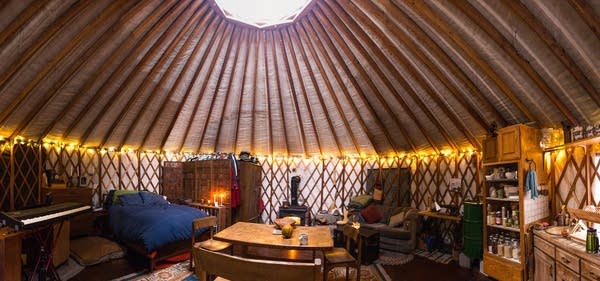Even in the frozen North, a yurt's so good

Go Deeper.
Create an account or log in to save stories.
Like this?
Thanks for liking this story! We have added it to a list of your favorite stories.
Grace Brogan and John Kamman live in a yurt.
It's a squat round structure with lattice walls, a dome skylight and a few layers of canvas over the whole thing — think of a tent with stiff walls. Tents are great in the summer, but this is winter. In northern Minnesota.
Why would two employed people with three master's degrees between them choose to live with only a quarter-inch of material between themselves and the elements? And how do they stay warm?
To find out, I drove a dozen miles north of Bemidji on a recent morning and hiked a quarter-mile across a snowy field. It was not yet dawn, and from the outside, the yurt's vinyl windows glowed with firelight.
Turn Up Your Support
MPR News helps you turn down the noise and build shared understanding. Turn up your support for this public resource and keep trusted journalism accessible to all.

Inside, a small home's worth of furnishings lined the circular wall. A calm mutt named Mabel loitered near the crackling wood stove. The yurt was actually a really nice place to be.
Grace, 29, works for Renewing the Countryside, a rural development and food systems nonprofit. John, 31, works for Ecology Project International — an organization that partners high school students with environmental scientists. Both work from the yurt via high-speed Internet, their only connection to the grid.
They are not hermits. They drive into town when they need to, and even flew to Mexico on business. "I don't want us to operate under the delusion that we're saving the planet by living in a yurt," John said. "For me, it's just fun to problem-solve our daily lives."

We sat down to talk about life in a yurt.
Most people go to college so they can afford certain modern luxuries, like electricity and a house with solid walls.
So why would Grace and John choose to live in an off-the-grid yurt?
"Eventually we want an off-the-grid house," Grace explained, "but the reality of being students for so long, and choosing the careers we're in, means that ideal is quite a ways off. The yurt is a good way to figure out a small solar panel system and to learn basic construction and be exposed to those things before we're 50."
"We didn't want to go take out a giant mortgage to build a house," John said. "We were able to buy this yurt used for $5,000. It's an option that was super affordable."
The yurt is 24 feet across, covering roughly 450 square feet. To build a simple cabin with those dimensions would be relatively inexpensive.
So why did they want a yurt?
"The idea of yurts entered our lives when I was working at the North House Folk School in Grand Marais in 2008," Grace said. "I just fell in love with the space and the light and the idea of understanding the systems around you in a much more immediate way. Even then, I was like, 'John, we have to do this.'"

The couple moved to their Minnesota yurt from Missoula, Mont., in May of 2013. They hoped for mild weather and got the coldest winter of either of their lifetimes. By now they have some experience staying warm.
How do they manage it?
"It's a matter of being constantly diligent to make sure the fire is going 24 hours a day," John said. "It's not the best-insulated place. It's a layer of canvas, and a covered layer of Reflectix [think bubble wrap coated in tinfoil]. So when it's really cold outside, below negative 10, we set an alarm to wake up and stoke the fire at 3 a.m."
But with temperatures plummeting every time the fire dims, how do they sleep comfortably?
"We have a huge down blanket," Grace said. "It makes all the difference. We never want to get out of bed in the morning."
Yurts don't generally come with septic systems, so Grace and John have an outhouse. In the winter, the seat lid is cold enough to build up a thick layer of frost.
Do they mind?
"No," Grace said. "Not really."
With no running water, how do they keep clean?
"We built a sauna behind the yurt," John said. "First we sweat it all out, then wash off in a basin. We're very mindful of water usage, since we have to haul it all in."
After a year and a half, do they recommend yurt living?
"It's not for everyone," John said.
Dear reader,
Political debates with family or friends can get heated. But what if there was a way to handle them better?
You can learn how to have civil political conversations with our new e-book!
Download our free e-book, Talking Sense: Have Hard Political Conversations, Better, and learn how to talk without the tension.





